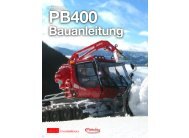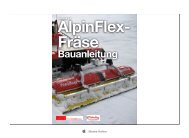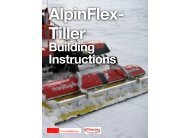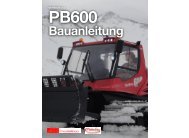PB400 Building Instructions PDF - AT modellbau
PB400 Building Instructions PDF - AT modellbau
PB400 Building Instructions PDF - AT modellbau
- No tags were found...
You also want an ePaper? Increase the reach of your titles
YUMPU automatically turns print PDFs into web optimized ePapers that Google loves.
VERSION 2.0<strong>PB400</strong><strong>Building</strong><strong>Instructions</strong>
Chapter 1PB 400 Body Kit 1:12With this kit you can build a body of the KässbohrerPistenBully 400 in scale 1:12. It will fit thePistenking chassis 1:12 as well as the chassis of theGraupner/Kyosho PistenBully and the Kyosho SnowBlizzard.Photo: Adrian Humbel
IntroductionIMPORTANT - READ FIRST• For building the model some basic knowledge inmodeling is necessary.• These instructions should be viewed as a guideline,which is giving the most important points forbuilding the body. Of course it is up to the eachmodeler to apply changes or improvements.• The kit contains only the parts for building the bodyand eventually the cockpit. A chassis andauxilliaries are NOT included.• Many of the included pictures show accessorieswhich are selfmade and which are not included inthe kit nor available for purchase.• We strongly recommend to take advantage of thelarge amount of available pictures for reference(e.g. on www.snow-groomer.com)Additional Materials Needed for AssemblyThese materials are not included, but can be obtained in any hobby store:• Glue: super glue (cyan acrylate), Pattex Repair Extreme or similar, alsorecommended plastic glue Ruderer L530 or equivalent• Paint: best results are obtained with an airbrush, alternatively spray cans can beused (be sure to use a spray can for modeling purposes). PistenBully red is RAL 3020• sandpaper 300/600 grain for preparing the PVC prior to painting• sandpaper 150 grain for leveling the casted cockpit parts• aluminum sheet metal for the platforms• aluminum or brass wire (circular), 3 mm for mirror holders• brass wires (circular) 4 mm and 2 mm for the rails (fence) of the platform• Optional: LEDs + reflectors and clips for lights• The kit is manufactured under a license ofKässbohrer Geländefahrzeug AG.2
For all those who might be turned off by thefull building instructions here a short summaryof the necessary tasks is given.The time needed largely depends howaccurate one likes it, and which details areapplied.The body can typically finished within oneweek (working every evening). The largesttime consumers are masking for painting andinstallation of the lights.• Cutting out of the parts• Cutting out of the air intake holes at the side air intakes• Installation and wiring of the lights (optional)• Glueing the parts together• Masking of the window areas, sanding of the areas to be painted with 600sandpaper and applying red paint (air brush or spray can recommended)• Masking and painting of the black areas• Cutting out of the parts• Cutting the platform from 5 mm ply wood + painiting, optionally glueing astructured aluminum sheet on the platform• Installation of the amber rotating beacons• Attaching the stickers• Installation of the cockpit• Bending of aluminum or brass rods (3 mm) for the rear view mirrors,installation of the mirrors• Attaching the body to the platform3
Driver CabinThe parts for the driver cabin and the cockpit are to be cut outalong the engraved lines. The pictures below show the cut bodyparts:4
Pic: cut out body parts, ready for assembly5
It is recommended to install the head lights in the roof beforegluing the parts together. The standard 5 mm LED reflectors canbe used. In order to have the light beam hit the ground at the rightposition in front of the snow cat the reflectors should be grindedat an angle of 15° at their front. The housing for the head lightsshould be painted black on their inside to prevent light fromshining through.The rotating beacons of Pistenking can be installed quite easily attheir location. Drill a 5 mm hole in the center and fix them eitherwith an M5- nut or glue them in place (see picture to the right).If a reflector for the rearward lights will be installed, the threadbase of the rotating beacon has to be shortened accordingly.Take care not to damage the electrical wires.Pic: Installation of the head lights6
Paint the sun roof from the inside with a transparent (non opaque)paint (grey), which is available at hobby stores to shade modelcar windows.Glue the parts together in the following order:1. Side parts are glued to the rear part; the sides are glued fromthe outside to the gluing area of the rear part. Preliminary installthe roof and fix it with tape to ensure the proper angle of theside parts. 2. Glue the roof to the side and rear parts, the roof overlaps allparts from the outside 3. Now all the interior work should be done, like installation andwiring of the rear lights and the rotating beacons Pic: Preliminary test fitting with tape4. Glue the front in place, it attaches to the outside to the sideparts and to the inside of the roof.Pic: Glueing areas at the upper rear corner7
Pics: Glueing areas at rearand frontPics: the “back pack” is assembled as shown from thelaser cut metal parts8
PaintingThe paint has to be applied from the outside, due to the gluing ofthe parts. Mask the window areas. Cover large areas with paperand only let a narrow stripe (about 5 mm) of the tape (ScotchMagic Tape) get in contact with the body. This will make theremoving of the tape much easier.Don't forget to cover the sun roof and the openings for the lights(roof, front, sides).<strong>AT</strong>TENTION:Prior to painting it is absolutely necessary to prepare the surfacewith 600 grain sandpaper and degrease the surface with rubbingalcohol.If you want to add the cockpit interior later, it is recommended tofirst apply a light gray primer.Paint the A-pillar (between wind shield and door) and the doorframe in satin black. The original windows are glued to the cabin,which can be nicely simulated by painting this area at the insidewith black. Pictures of a finished model with partly self made accessories9
Pictures of a finished model with partly self made accessories10
Pictures of the original for reference:Type to enter text11
StickersApply the silver stickers as shown in the pictures above.Apply the warning stickers as shown:Photos: Eric SentFahrerseite = Drivers Side12
Cockpit• The cockpit kit is available as on option to the bodykit.• If the Kyosho Blizzard chassis is used, the batterypack has to placed elsewhere to make room for thecockpit.• Many of the included pictures show accessorieswhich are selfmade and which are not included inthe kit nor available for purchase.• Accessories like the driver figure are NOT included.Sand the center console with 600 grain sanding paper and paint the outside insatin black. If you want to install lights for the instruments and screen, cover thisarea prior to painting (see picture below). In this case make sure, that no clouds orstripes can be seen against a bright light. Typically 3-4 layers of paint arenecessary. If some light shines through at edges or corners just paint from insidewith a brush. The lighting can be done with one or two LEDs from inside.Note: the far right of the large circular dials is the for the pulling force of the winchand therefore only installed in the winch version PB 400 W. If no winch is installeda storage box is installed instead (see pictures of the original).The cockpit itself can be glued to a fitting aluminum sheet which is connected tothe driver cabin.The front side of the computer screen is grinded to a flat surface of 150 sandpaperwith circular motions. Apply the stickers.13
Pic: Connecting the cockpit to the driver cabinPic: Original cockpit14
Sand the seats with 600 grain sanding paper and paint theoutside in flat dark gray and flat red as shown below. Thebackside is made from balsawood, which has to be fittedaccordingly and glued into place. Paint it in dark gray. Bent asmall piece of aluminum sheet and use it to glue seat cushion andback rest together.Pic: Assembly of seat parts with alu sheetPic: Cover backside with balsa woodPic: assembled and painted seat15
Glue the seats onto the vacuum formed and black paintedsockets.Pic: Socket for seat, needs to be cut to fitFinally glue the pieces to the platform and install the driverscabin. The ROPS sticker is placed outside on the wind screen inthe lower left corner.Driver figures in 1:12 are available at doll house stores. Obviouslyyou will not find a snow cat driver there, but a fitting doll is easilyfound and adapted to our needs.Pic: Assembled cockpit with driver figure16
Versionen2.00 (6.6.12) Release as eBook, minor changes1.0 (4.1.10): First versionxvii
Copyright© 2012 <strong>AT</strong> engineering, LLC - Golden, CO - USAAll texts, pictures and drawings are owned by <strong>AT</strong> engineering, LLC and may not be used withoutprior written approval.A large part of the pictures was kindly supplied by Adrian Humbel, whom we thank very much.PistenBully and Kässbohrer are registered trade marks of Kässbohrer Geländefahrzeug AG.<strong>AT</strong> is a registered trade mark of <strong>AT</strong> engineering, LLCxviii






